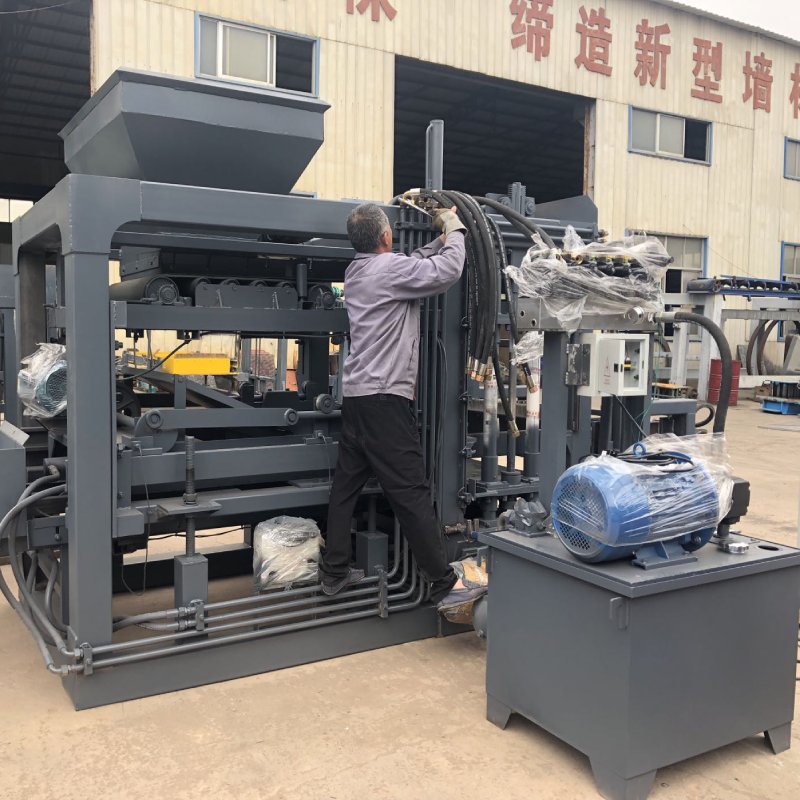
Image source Aiwei Block machine
loT-Enabled Block Brick Making Machines Allow Real-Time Monitoring and Control
Introduction
In the era of Industry 4.0, the integration of cutting-edge technologies has reshaped traditional industries, and the construction sector is no exception. The emergence of the Internet of Things (IoT) has revolutionized the way construction machinery operates. Among these innovations, IoT-enabled block brick making machines have emerged as a game-changer, offering real-time monitoring, control, and optimization of the production process. This article delves into the world of IoT-enabled block brick making machines, exploring their benefits, functionalities, and the transformative impact they are having on the construction industry.
IoT in Construction: A New Frontier
The Internet of Things (IoT) refers to the network of physical objects embedded with sensors, software, and connectivity, allowing them to collect and exchange data. The construction industry, traditionally associated with manual labor and heavy machinery, has embraced IoT to enhance efficiency, safety, and sustainability.
IoT-Enabled Block Brick Making Machines: An Overview
IoT-enabled block brick making machines incorporate a range of sensors, communication modules, and data analytics capabilities. These machines are designed to connect to a central network, allowing real-time data transmission, analysis, and remote control of the manufacturing process.
Benefits of IoT-Enabled Block Brick Making Machines
- Real-Time Monitoring: IoT integration enables operators to monitor every stage of the brick-making process in real time. Data on material input, mixing, molding, curing, and quality can be accessed remotely, allowing for immediate intervention if any anomalies are detected.
- Predictive Maintenance: The sensors embedded in IoT-enabled machines provide insights into the health and performance of various components. This data allows for predictive maintenance, reducing downtime and minimizing costly breakdowns.
- Optimized Efficiency: By analyzing data collected during the production process, IoT-enabled machines can identify inefficiencies and bottlenecks, allowing operators to make real-time adjustments to optimize the workflow.
- Quality Assurance: Real-time data monitoring ensures that the quality of each brick meets the desired standards. Any deviations can be addressed promptly, leading to a consistent and high-quality product.
- Remote Control and Automation: Operators can remotely control certain aspects of the machine’s operation, such as adjusting mixing ratios, optimizing curing conditions, and altering production rates. This remote control capability enhances flexibility and adaptability.
Functionality of IoT-Enabled Block Brick Making Machines
- Sensors and Data Collection: IoT-enabled machines are equipped with sensors that capture data on factors such as material composition, temperature, humidity, pressure, and vibration. This data is then transmitted to a central system for analysis.
- Real-Time Data Transmission: Data collected from sensors is transmitted in real time to a centralized database or cloud-based platform, allowing operators to access information from anywhere at any time.
- Data Analytics and Insights: Advanced data analytics tools process the collected data, providing actionable insights into production trends, performance metrics, and potential areas for improvement.
- Remote Control and Adjustments: Operators can remotely adjust parameters such as mixing ratios, curing conditions, and production rates, based on real-time insights and feedback from the data analysis.
- Alerts and Notifications: IoT-enabled machines can generate alerts and notifications when predefined thresholds are exceeded or when anomalies are detected, enabling prompt response to critical situations.
Impact on the Construction Industry
- Enhanced Productivity: The real-time monitoring and optimization offered by IoT-enabled machines lead to improved efficiency, reduced downtime, and increased overall productivity.
- Quality Assurance: The ability to monitor and control production processes in real time ensures consistent quality, reducing material wastage and rework.
- Cost Savings: Predictive maintenance and data-driven decision-making reduce maintenance costs and minimize production disruptions, resulting in cost savings over the long term.
- Safety and Risk Mitigation: Remote monitoring allows operators to address potential safety risks and hazards in real time, contributing to a safer working environment.
- Sustainable Practices: The optimized production process and reduced waste associated with IoT-enabled machines align with sustainable construction practices, lowering the industry’s environmental impact.
Challenges and Considerations
- Data Security: The collection and transmission of sensitive production data raise concerns about data security and the potential for cyberattacks.
- Integration Complexity: Integrating IoT technology into existing machinery and workflows requires careful planning and technical expertise.
- Skill Requirements: Operators and maintenance personnel need to be trained in working with IoT-enabled machines and interpreting data analytics.
Conclusion
IoT-enabled block brick making machines have ushered in a new era of connectivity, real-time monitoring, and control in the construction industry. The ability to remotely oversee production processes, predict maintenance needs, and optimize workflows offers unprecedented advantages. As the construction sector continues to embrace technological innovation, IoT-enabled machines stand as a testament to the power of data-driven decision-making, efficiency enhancement, and the potential for reshaping the construction landscape. In the age of Industry 4.0, IoT integration in block brick making machines is not just a technological advancement—it’s a transformative force that is propelling the construction industry into a new era of efficiency and sustainability.
